Aconitum napellus, MonkshoodMonkshood, Helmet flower, European AconiteOu Wu Tou (TCM) |

|

|
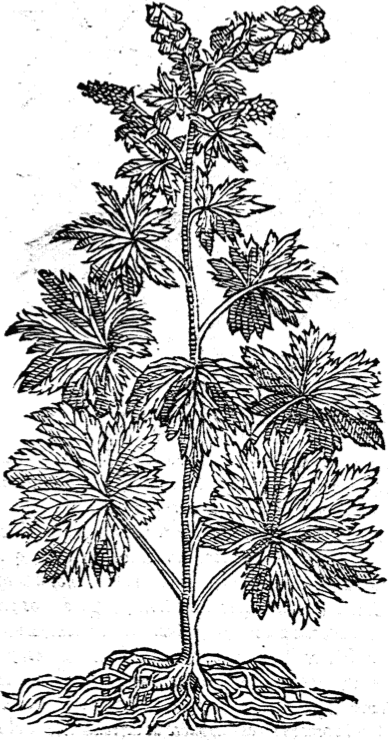 Dioscorides Materia Medica, Mathias, 1563
Dioscorides Materia Medica, Mathias, 1563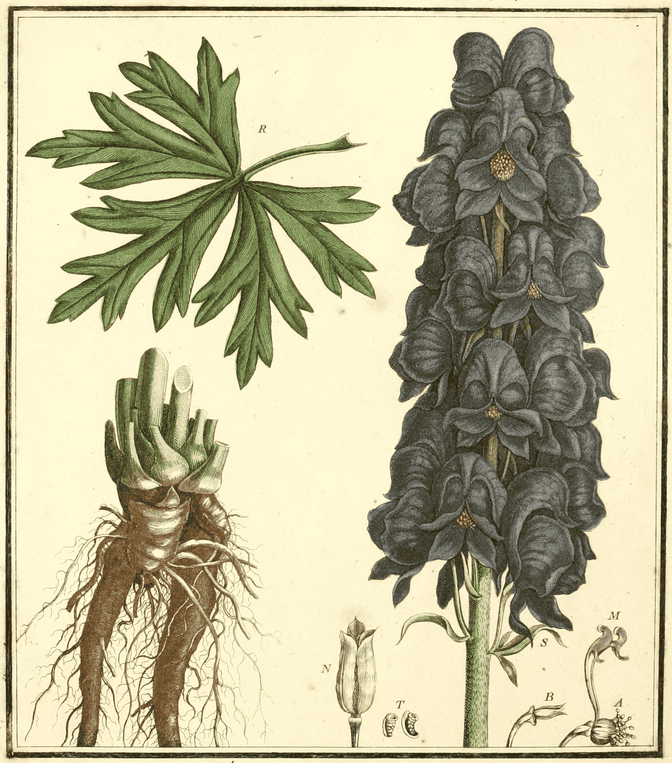 Bulliard, P., Herbier de la France (1780-1798)
Bulliard, P., Herbier de la France (1780-1798)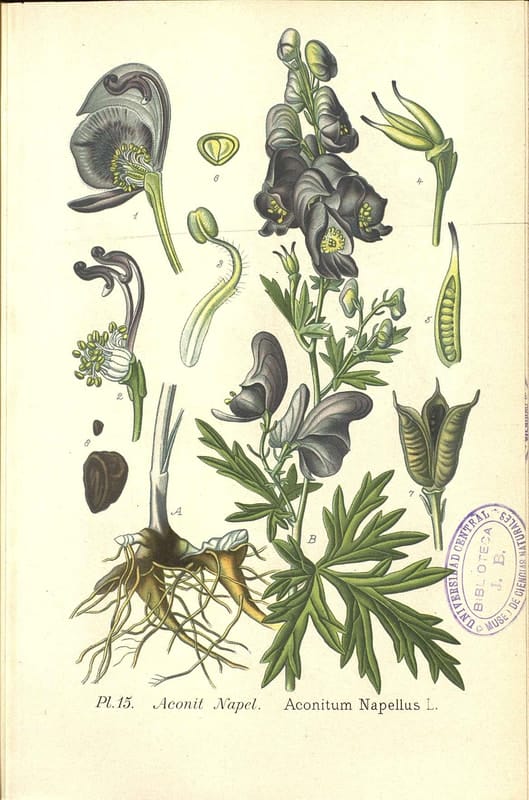 Masclef, A., Atlas des plantes de France (1890-1893)
Masclef, A., Atlas des plantes de France (1890-1893)
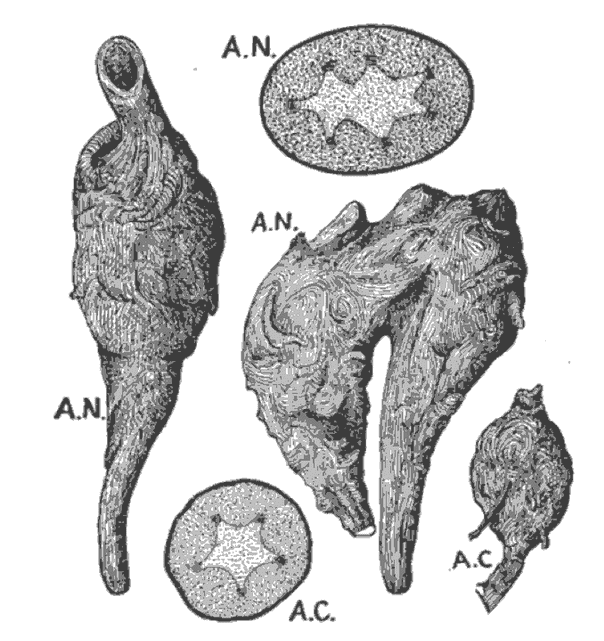
|
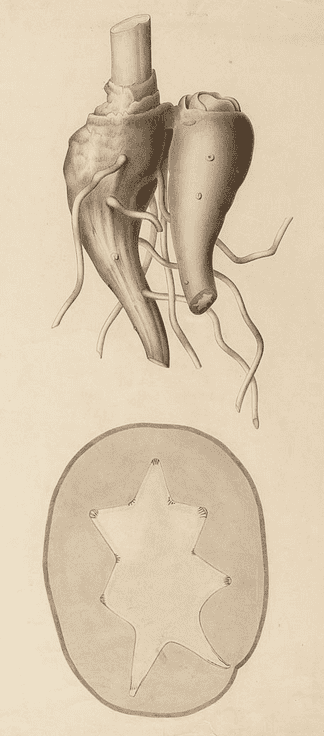
|
|
Dried Roots and cross-section. A.N. denotes A. napellus; A.C. denotes A. cammarum (Notes on Pharmacognosy, Otto Augustus Wall, 1902) |
Root and cross-section of the root, (Botanische wandplaten, ?) |
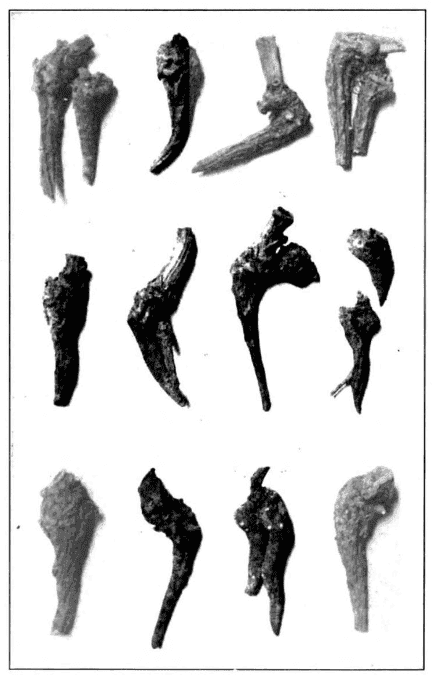
|
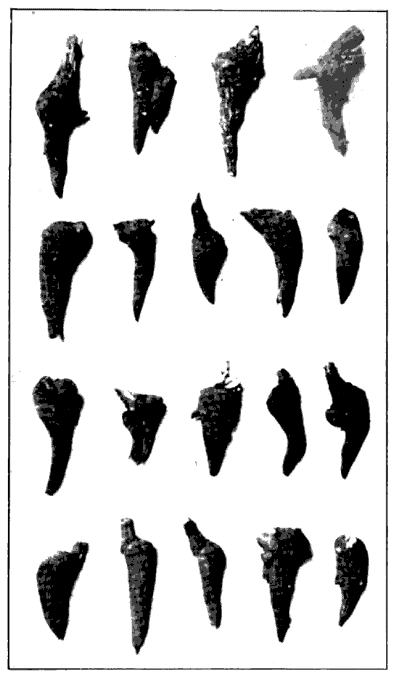
|
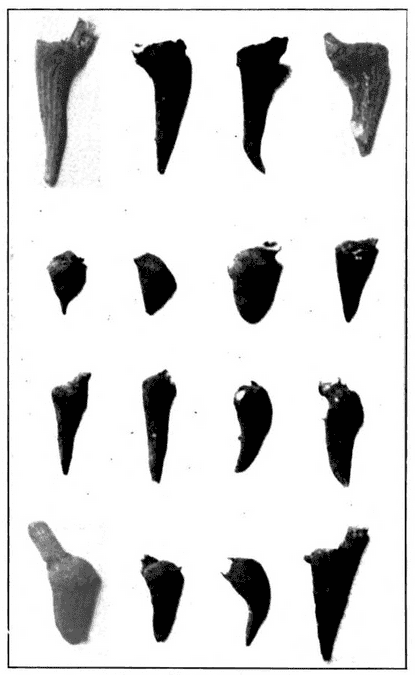
|
Left: A. napellus, some with ‘daughter’ roots; Center: A. stoerckianum; Right: Japanese Aconite
A Text Book of Pharmacognosy, Heber Wilkinson Youngken, 1921
See also:
Photos of Chinese Aconite
The Aconite Species of the West
Experiments on Aconite of Dr. Storck
The following texts are available for download from Google:
An Inquiry Into the Physiological and Medicinal Properties of the Aconitum, By Alexander Fleming, 1845
On the Medical Properties of the Natural Order Ranunculaceae, Turnbull, 1836
Botanical name:
Aconitum spp:
Several Aconite species have been used in Europe as ‘Aconitum’:
- A. napellus (Official species)
- A cammarum
- A. stoerckianum
The Aconitum napellus of the West is pharmacologically equivalent to the main Aconite species of East:
- Aconitum carmichaeli (Fu Zi) of TCM
- A. ferox, A. chasmanthum (Ayurveda–Bish and Tibetan Medicine–Bong nga nag po)
Aconite species supplying the various medicine markets are complex, often a number of species apparently being collected indiscriminately. Wild versions of this plant are extremely toxic, some more than others.
Parts used:
Root, Leaf
Temperature & Taste:
Hot, dry. Pungent, Extremely Toxic
‘They are hot and dry in the Ultimate of the fourth Degree’ (Salmon)
Classifications:
T. External Medicines
Uses:
1. Regulates Qi, Clears Inflammation, Resists Poison:
-various Fevers
-Pleurisy, Pneumonia
-Constitutional Syphilis
-Poisons and Venom, including Viper and Scorpion
-Cancer
2. Warms the Kidneys, Clears Cold:
-Edema; ‘Edema of a passive nature’
-Amenorrhea due to Coldness
3. Clears Cold-Wind-Damp, Eases Pain:
-Arthritic and Rheumatic diseases
-useful for Damp and Melancholy disorders
-Leprosy, Leukoderma (painted on or taken orally, Avicenna)
-internally for Chronic Ulcers
4. Externally:
-Neuralgic pain, especially Sciatica, Migraine, Trigeminal Neuralgia (tincture painted on)
-Arthritic and Rheumatic pain
-applied topically to ‘foul and filthy Ulcers’ (Salmon)
-ointment can be applied to kill Lice (Salmon)
-a lye prepared from the ashes is applied to ‘Morphew, Scurf, Dandruff, Scabs, Itch, Pimples, Tetters, Ringworm, Leprosy’, used as a wash regularly (Salmon)
-distilled water is dropped into the eyes for heat and redness of them (Salmon)
Dose:
1. Dose should always begin small, increasing as needed.
2. As per Chinese use, the addition of Licorice and/or Ginger root is wise.
3. Despite the fact that the root was not prepared in the West, it would be wise to prepare the root based on either Ayurvedic or TCM methods.
4. The unprepared root can be used in external applications, but only on small areas and not on broken skin.
5. Individual response can be varied. Some people may experience mild side effects within the dosage range while others can take far larger doses.
6. Tolerance is developed meaning doses can generally be increased if required.
Dose of Aconitum napellus root in European usage: 1–8 grains, (65–500mg) gradually increased
Preparation:
See the Chinese and Indian Aconites for processing methods.
Correctives:
1. Fresh Ginger, Licorice (TCM)
2. Leaves of the Castor plant (Unani)
Substitutes:
1. For internal use it is far safer to use prepared Aconitum Zhi Fu Zi instead of dried root of A. napellus.
2. Delphinium denudatum (Unani)
Comment:
1. Aconite was long known as a poison in the West, but was rarely used medicinally. It was largely popularised in the West by the experiments of Storck.
2. Despite the Eastern species being pharmacologically equivalent to A. napellus, we have separated them as the Western uses are quite different.
3. Aconite is a very potent medicine and is responsible for more deaths in China than any other single herbal medicine. Nevertheless, it is a potent and indispensable medicine in TCM, Tibetan Medicine and Ayurveda.
4. There are a number of types of processing methods used. Once prepared, the root should not be numbing to the tongue.
Main Combinations:
1. Arthritis, Rheumatism:
i. Aconite extract, Saltpeter
ii. Aconite extract, Guaiacum resin, Licorice
iii. Aconite extract, Guaiacum resin, Calamus
iv. Aconite extract, China root, Guaiacum resin
v. ‘Nervous Gout’, Aconite with Valerian (Sobernheim, 1840)
vi. Rheumatism, Aconite extract (1 scruple), Licorice powder (1 dram), with Elder juice thickened sufficient to form 40 pills. Take 1 pill every 2 hours until relieved (maximum 4 or 5 pills in 24 hours) (Sobernheim, 1840)
2. Gout, Aconite extract, Bittersweet, Arnica flower, Guaiacum, Calamus
3. Gout, Rheumatism, skin Diseases, Extract of Aconite, Sublimed Sulphur, Elder infusion
4. Viper Bites: ‘Sometimes Poisons are so great puislant to Poison, that Wolfsbane given in warm wine is approved to be a most wholesome medicament for those that are stung by a Viper or a Scorpion, as some most experienced physicians affirm’. (Mizaldus)
5. Foul and filthy Ulcers, used with Licorice as a powder, it is sprinkled onto the Ulcer. It cleanses and dries them, disposing them to healing. (Salmon)
6. Red, sore, inflamed Eyes, mix the distilled water of Aconiute with Rose water (equal parts) and use as eye drops (Salmon)
Major Formulas:
Notopterygium 29 Pills (Spru nag nyer dgu)
Cautions:
1. Extremely toxic in its unprepared state. Even the prepared drug is highly toxic in overdose. A number of deaths occur each year in China from Aconite poisoning.
2. Only the prepared root should be used internally.
3. It is wise to begin with lesser doses, increasing as needed. Cooking time can also be longer to begin with (2 hours), reducing cooking time over a number of days.
4. ‘Generally half dirham (1.75 gm) of it is considered fatal, but in my opinion a lesser dose may also be fatal’. (Avicenna)
Antidotes:
1. Licorice (TCM)
2. Ginger (TCM)
3. Garlic
4. Asafetida
5. Ground Pine: “It is an especial thing for the Poison of the Aconites of all sorts”. (Culpeper)
6. Herb True-Love: ‘The leaves or berries thereof are effectual to expel Poison of all sorts, especially that of the Aconites’. (Culpeper)
7. Long Birthwort ‘is the most especial antidote against all Aconites’. (Petrus Aponensis)
8. Rue, Centuary, Oregano, Marrubium, Sea Holly were all list as effective antidotes (De venenis, Ramesey, 1663)
9. Anthora (Aconitum anthora) was regarded as a specific antidote to the toxic Aconites. Anthora is a non-toxic (less toxic) species of Aconite. Similarly, in Tibetan Medicine, non-toxic (less toxic) species of Aconite (A. heterophyllum etc.) are regarded as counterpoisons to the toxic Aconites.
10. Delphiniums are closely allied to the Aconites. D. denudatum has, similar to the above-mentioned Aconites, been regarded as an antidote to the toxic Aconites.
11. Purified Borax is regarded as an antidote in Ayurveda. Recent research has shown it to be an effective antidote to both acute and sub-acute Aconite poisoning.
12. Sealed Earth with Butter and Hydromel. (De venenis, Ramesey, 1663)
13. Mithridate and Theriac were commended by some. Also Diatessaron.
14. Mithridate, Earth of Lemnos, Bay berries (2 oz. each), flies that have fed on Napellus (24 in number, dried and powdered). Form an electuary with Honey and oil. Dose: 1–2 drams with wine. (Guainerius)
15. Decoction in wine of Oregano, Pennyroyal, Sage, Southernwood, Wormwood, Gentian (Salmon)
16. Zedoary (1 scruple), Frankincense (half scruple), Bezoar (7 grains), Musk, Ambergris (2 grains each). (De venenis, Ramesey, 1663)
17. After vomiting, Emerald in fine powder (2 drams) taken with wine. “They die unless they recive Emerald” (De venenis, Petrus, 1487)
18. Musk is an “Antidote for poisons specially for Aconite” (Avicenna)
19. Bezoar
20. Inflammation of the mouth and face, Rose water as a mouthwash and to wash the face.
21. “Mathiolus relates that he once brought back from death [by applying] the oil of the Scorpions to the Heart“. (De venenis, Ramesey, 1663)
22. Case of Poisoning by Aconite Treated by Digitalis: Recovery
Main Preparations used:
Tincture, Tincture of the juice, Extract
1. Extract of Aconitum napellus:
The dose of the extract is always begun small but can be increased to 5 grains per dose.
i. Fresh Aconite leaves (1 pound). Bruise in a stone mortar, sprinkling with a little water. Express the juice well, and without depurating, evaporate to a proper consistency. (London)
ii. Bruise fresh Aconite leaves (1 pound) in a stone mortar, express the juice; then boil the expressed herb in 3 pounds of water, strain and express. Mix the juice and decoction and evaporate together to an extract. (Piderit)
iii. Bruise the leaves, express the juice and evaporate until thick enough to be made into an extract with sufficient powdered Aconite herb.
How to administer the extract:
i. Aconite extract (4 grains), White Sugar (half oz.); divide into 4 doses
ii. Aconite extract (2 grains), White Sugar (20 grains); divided into 2 doses
iii. Aconite extract (3 grains), Sugar (1 dram); divide into 3 doses.
Mix. The dose begins with sufficient to give 1 grain of extract, increasing as needed.
2. Tincture of Aconite:
Aconitum napellus herb (1 ½ oz.), Alcohol (1 pint). Extract, express and filter. (Pharmacopoeia Regni Poloniae, 1817)
3. Tincture of Aconite Juice:
i. freshly expressed Aconite juice, Alcohol (equal parts). Digest several days, filter, and keep. Used especially for Gout and Rheumatism. Dose: 10 drops, cautiously increased to 60 drops. (Niemann)
